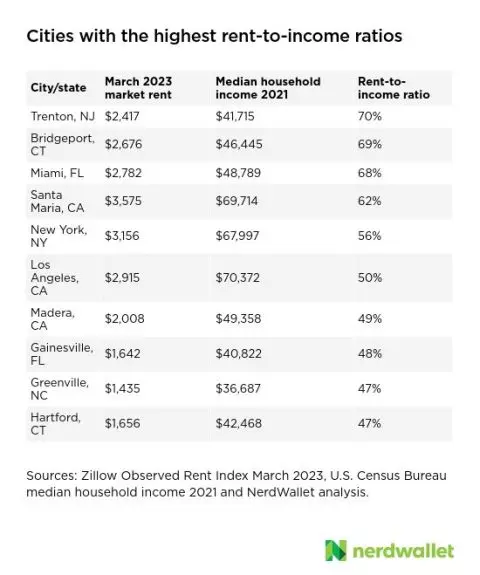According to the latest data on rents in the market and median incomes, most U.S. Cities are unaffordable. Trenton, New Jersey has replaced Bridgeport, Connecticut at the top of this month’s “unaffordable cities” list.
Unaffordable can mean different things to different households, but as a general rule you shouldn’t spend more than 30% on rent. Federal standards would consider median income earners of six cities to be “severely burdened by rent”
Janesville, Wisconsin ranked third in affordability among cities surveyed last month, but this time it was the city that renters found most affordable.
NerdWallet’s monthly rent-to income ratio analysis of 225 U.S. cities found that 65% of the rents in the market in March were at or above the 30% recommended ratio. In February, it was 65 %.
Market rents are considered moderately to seriously burdensome by residents of 65% U.S. cities. The data for market rents comes from Zillow’s real estate website, which is based on data from March. Median incomes used in this analysis are from the 2021 U.S. Census Bureau. The data does not differentiate between residents of those cities who rent or own their homes.
According to federal standards, a household that spends 30% to 49% on rent is considered “moderately rent-burdened,” while a household spending more than 50% is classified as “severely rental burdened,” says the NYU Furman Center which conducts research in housing and urban policy.
Six of the 225 cities studied have rent-to income ratios that place renters earning median incomes into the “severely rental burdened” category by March 2023.
-
Trenton, New Jersey: 70%.
-
Bridgeport, Connecticut: 69%.
-
Miami: 68%.
-
Santa Maria (California): 62%.
-
New York City, 56%.
-
Los Angeles: 50%.
According to a Zillow 2015 analysis of U.S. Census Bureau statistics, renters who have the most financial burden are usually seniors, low-income families, immigrants, and racial/ethnic minorities.
According to Zillow’s March 2023 rental data, here are the cities that have the most and least affordable housing markets.
Rents are increasing or decreasing
Zillow’s March 2023 rental report shows that the advertised rents rose by 0.5% from February to March. Zillow’s report shows that this monthly increase is less than the 0.6% average increase in March observed between 2016 and 2019. In February, the monthly rent rose 0.3%. The average asking rent in March rose by 6%, to $1996, compared to the same period last year. This is just behind the national peak of $1.997, which will be reached in September 2022.
Only two of the 49 cities Zillow tracks for its monthly Observed Rental Index saw rents decrease from February to march: Detroit (-0.13%), and Portland, Oregon, (-0.03%). Richmond, Virginia (0.04%), Pittsburgh (0.1%), and Salt Lake City (3.37%) had the lowest increases in rent. The cities with the largest rent increases between February and March were Sacramento, California (31.9%), Boston (10.6%), Hartford, Connecticut (0.97%), New York City (0.93%), and Cincinnati (0.88 %).
Rent growth peaked in February 2022 at 17% (since Zillow began tracking data in 2016), and has slowly declined since then. March’s annual growth rate is 11 percentage points lower than the previous high. Cincinnati had the largest annual rent increase for March, an increase of 9.2% when compared with March 2022. Las Vegas was only city that saw a decrease in rent in March compared to the previous year.
Rent is a major contributor to inflation. Rent, which is included in shelter, makes up the largest portion of the CPI (34%) used as a proxy to measure inflation. According to the latest CPI released on April 12, shelter contributed more than 60% to the increase in core inflation for March. This excludes food and energy.
According to the report, the shelter index has increased by 8.2% in the past year. The lag between the reporting of rent data and current inflation means that current inflation may not reflect market conditions. This is due to the lease renewal cycle, which most often lasts around a calendar year.
Despite this lag, rent-specific CPI portion has outpaced inflation overall for decades.
Methodology: Rent-to-income ratios by metro area
NerdWallet matched the latest available market rental data from Zillow Observed Rent Index with the U.S. Census Bureau’s most recent median household income (2021) data. Some cities included in the Zillow Observed Rent Index were not included in the U.S. Census Bureau’s list of median incomes for each city, and therefore weren’t considered in this analysis. Both sets of data identified 225 cities. NerdWallet then calculated the rent to income ratio by using the formula: Market Rent/(median Income/12 months ).
(Photo taken by Joe Raedle via Getty Images News)
